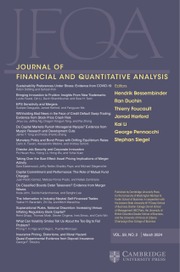No CrossRef data available.
Article contents
Common Lender, Ex-Banker Director, and Corporate Investment
Published online by Cambridge University Press: 25 September 2023
Abstract
Due to the government-driven mergers of large banks, many competing firms in Japan ended up borrowing from a common lender. Using firm-level data, we find that the capital investments of competing firms that share a common lender decrease by 15% of the mean. When a common lender can exercise its voice through its former employees serving as firms’ executive directors, investments fall significantly further. Competing firms that share a common lender increase markups and profitability ratios, suggesting that the lender induces strategic coordination among its borrowers to reduce their competitive pressures. Firms use saved resources from weaker competition for cash cushions.
- Type
- Research Article
- Information
- Journal of Financial and Quantitative Analysis , Volume 59 , Issue 8 , December 2024 , pp. 3959 - 3993
- Creative Commons
- This is an Open Access article, distributed under the terms of the Creative Commons Attribution licence (http://creativecommons.org/licenses/by/4.0), which permits unrestricted re-use, distribution and reproduction, provided the original article is properly cited.
- Copyright
- © The Author(s), 2023. Published by Cambridge University Press on behalf of the Michael G. Foster School of Business, University of Washington
Footnotes
We thank an anonymous referee, Allen Berger, Arnoud Boot, Richard Boylan, Stephen Brown (discussant), Ben Charoenwong, Dong Beom Choi (discussant), Hans Degryse, Mara Faccio (the editor), Bruce Grundy, Richard Hynes, Kei Kawai, Randall Morck, Phong Ngo, Greg Nini, Farzad Saidi, David Smith, Daniel Streitz, Xianming Zhou, and seminar participants at the Australian National University, the Reserve Bank of Australia, and Queensland University of Technology. We also thank participants at the 2021 Financial Intermediation Research Society (FIRS) Annual Meeting, the 2021 FIRN Annual Meeting, and the 2022 Conference on Empirical Legal Studies (CELS). We acknowledge financial support from the Australian National University Research School of Finance Actuarial Studies and Statistics. Any remaining errors are ours.


